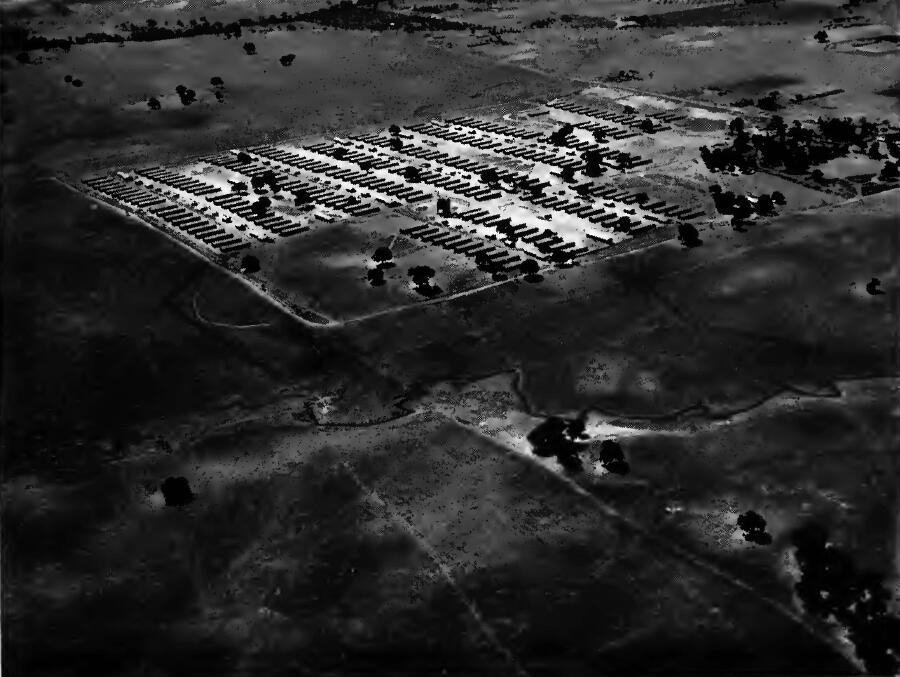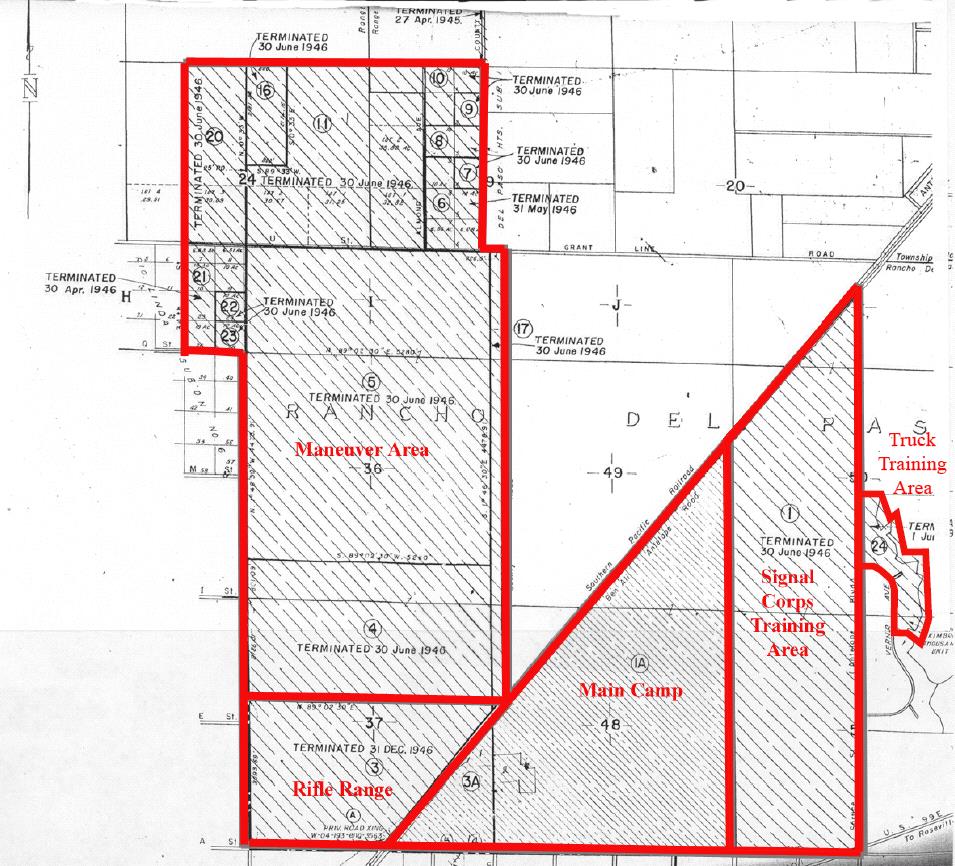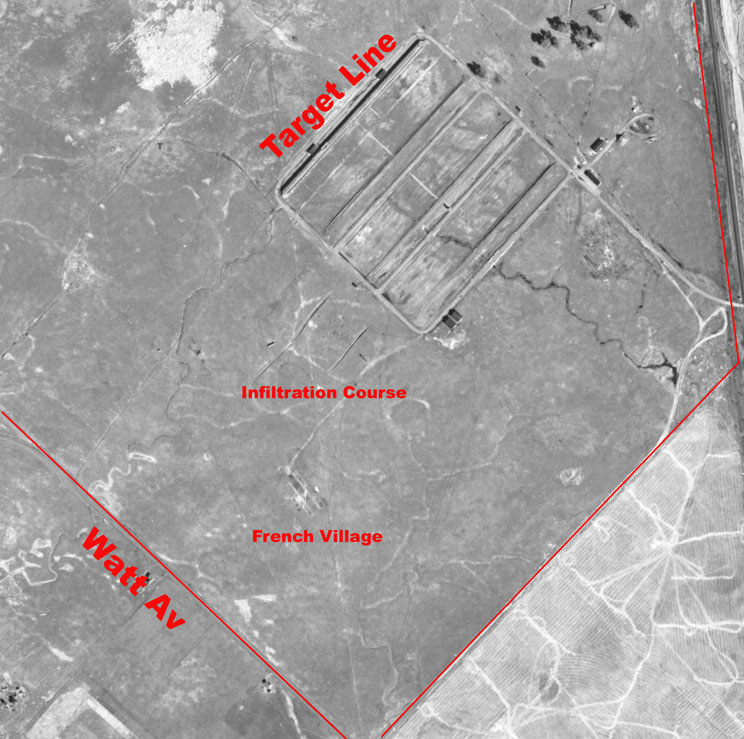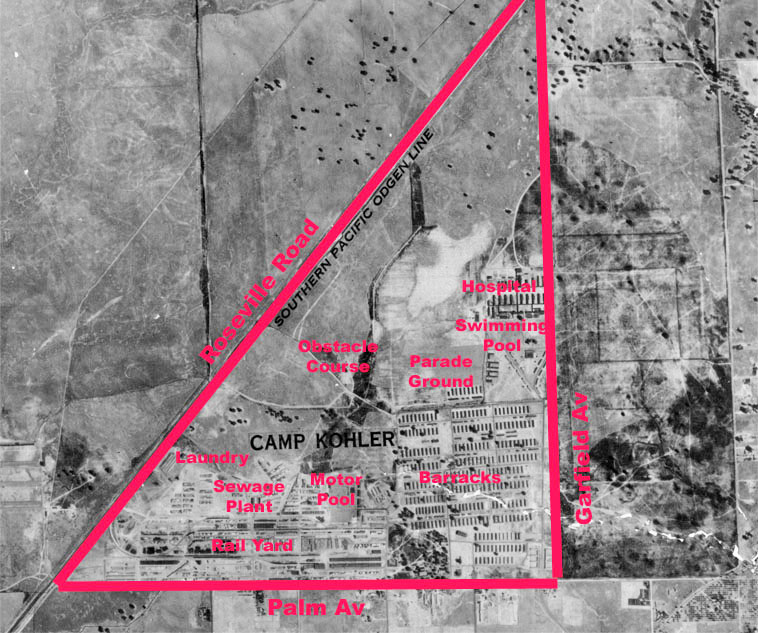(Sacramento Assembly Center, Walegra Engineer Depot, Prisoner of War Branch Camp)


Constructed at a migrant workers camp 15 miles northeast of downtown Sacramento, this assembly center was also known as Walerga. It was occupied for 52 days, from May 6 to June 26, and held a total of 4,770 persons, with at maximum at one time of 4,739. Evacuees were from Sacramento and San Joaquin counties. Aerial photographs indicate there were 11 blocks with over 225 buildings; one block was likely devoted to the military police and administration. Once the center was closed, it was turned over to the Army Signal Corps and became the basis of Camp Kohler.
The assembly center area is now bisected by Interstate 80 and covered by recent housing subdivisions in what is now the "Foothill Farms- North Highlands" area of Sacramento. There is a historical marker, a ramada, and a small grove of cherry trees at a small neighborhood park and playground (Walerga Park) at the northwest corner of Palm Avenue and College Oak Drive, within what once was the assembly center The monument incorporates a small concrete slab that may be a remnant assembly center foundation.

Between July 1942 and April 1946, the War Department leased or acquired 3,821.29 acres of land for Camp Kohler. Most of the property was undeveloped land used for maneuvers and field training. The more than 500 buildings on the camp were almost all of raised wooden construction. A small arms practice range was constructed east of the Southern Pacific Railway line near the current location of Karl Drive. A large laundry facility was operated on the property and transferred to McClellan AFB on 3 August 1950. This property was also the location of a sewage treatment plant that was transferred to the County of Sacramento in June 1956 and demolished in 1972

In 1946, the leases on 3,014.68 acres of Site property were terminated and the property returned to its prewar owners. Of the remaining 805 acres, 769.71 of the leased acres were terminated between 30 June 1952 and 25 February 1974. At the present time there are 35.30 fee acres and 0.11 easement acres remaining as active property of the United States Air Force under lease to the FAA. In 1946-47, many of the wooden buildings at the Site were sold to the public for demolition and salvage. In June 1947, a fire swept through the Site, burning numerous buildings. Since 1947, the Site has been developed with residential and commercial buildings. In 1954, Interstate Highway 80 was constructed through the southwestern portion of the Site. The only identifiable structures from former Camp Kohler that remain are the foundation of the laundry facility, the back wall of the rifle range, the base swimming pool, and buildings that were moved from the Site or built from salvaged materials from former Camp Kohler.
Range Area

Main Post Cantonment Area

The Main Post Area consisted of 20 leased parcels totaling 805 acres. The Main Post Area was used for housing, feeding, medical care, and other support functions for Camp Kohler personnel. The area contained 517 numbered structures, including 300 barracks buildings, a recreation hall, swimming pool, officers club, 330-bed hospital, five small obstacle courses in the barracks area, a large obstacle course, laundry facility, sewage treatment plant, railroad yard, motor pool with gas station, parade area, water tower, stockade, and fire station.
The 1945 aerial photograph (Figure 3 23) shows the property just prior to termination of its leases to the War Department and return to civilian ownership. The photograph shows the barracks, swimming pool, officers club, hospital, obstacle course, parade ground, motor pool with gas station, water tower, laundry facility, sewage treatment plant, and railroad yard.
The Walerga Assembly Center barracks were occupied for 52 days, from May 6 to June 26, and held a total of 4,770 persons, with at maximum at one time of 4,739. Evacuees were from Sacramento and San Joaquin counties. Aerial photographs indicate there were 11 blocks with over 225 buildings. These barracks became the Camp Kohler barracks in blocks 1600, 2600, 3600, 4600, 2700, and 3700.
The former Camp Kohler barracks were supplied with electricity via overhead lines. No transformer sites have been identified from maps or photographs. The property around the barracks was undeveloped. Street paving and landscaping were minimal. According to 1943 and 1944 health and welfare reports, garbage from the barracks and mess halls was hauled to local farms to feed hogs and the pit latrines were used in the barracks areas. Some combustible waste was burned on site.
The 1945 Camp Kohler Layout Plan shows five small obstacle courses in the barracks area. Photographs from the period of Army use show minimal fixed structures and the areas are not identifiable from aerial photographs. Photographs from the period show these areas to have been sand pits and climbing apparatuses. These appear to have been exercise areas adjacent to the barracks.
The 1945 Camp Kohler Layout Plan shows a large Officer's Mess and Lounge south of the base hospital
The water tower appears on the 1945 Camp Kohler Layout Plan at the intersection of Allen Street and Evans Road, currently just west of the parking lot for Foothills Farm Junior High School. It was the location of a US Geological Survey benchmark, which was described by the Coast and Geodetic Survey 1954 as follows: "The station is situated at the top and center of Camp Kohler water tank, located about 2 miles south of the Antelope post office and about 2-1/2 miles northeast of McClellan Air Force Base, in the northeast part of the military reservation. The tank is a wooden structure supported by many large timbers. The tank has an inside diameter of 42.6 feet, a capacity of 125,000 gallons and is 128 feet high." A 1957 aerial photograph of former Camp Kohler shows no sign of the tank. The 1970 National Geodetic Survey notes: "The tank has been removed and nothing remains to mark its location."
The 1945 Camp Kohler Layout Plan shows a 73.46 acre parade ground directly west of the base hospital). No structures are indicated in this area in any photographs or documents. The southeast corner of the parade ground is identified on the 1945 Layout Plan as "oiled and Graveled Area." The Foothills Baptist Church, Robert Frost Park, and the Foothills High School football stadium now occupy the site of the Parade Ground. The stadium sits directly on top of the corner of the parade ground labeled "oiled and graveled area." The area was completely excavated during the recent construction of the stadium.
The 1945 Camp Kohler Layout Plan shows a hospital complex of 34 numbered buildings. Reports from the Camp Chief Surgeon catalogue the history, staffing, facilities, and patients treated during the two and a half year life of the hospital. The former site of the Station Hospital is currently occupied by Foothills High School, which is part of the Grant Joint Union School District, and by residential housing between Merton Way and McCloud Drive (Figure 3 38). None of the former Camp Kohler structures appear to still exist, with the exception of the Foothills High School swimming pool.
The salvage of former Camp Kohler's structures took place in 1946 and 1947. Shortages of building materials made the structures valuable and they were sold to the public. Mr. Wayne Wesner of Fair Oaks, California, participated in the removal and rebuilding of the former Camp Kohler Theater in 1947. The building is now part of the Sacramento Adventist Academy at 5601Winding Way. According to Mr. Wesner, the buildings were sold "for almost nothing-a couple of dollars each." The Site was largely cleared of buildings, and, "There was very little out there when it was done." Mr. Norman Moreland of Citrus Heights, California, and Mr. George Moreland of Applegate, California, stated that they removed a two-story structure from former Camp Kohler and combined it with a similar structure purchased as salvage from Camp Beale, California. The building remains on Karl Drive in North Highlands, California.
A large fire on June 20, 1947 destroyed most of the remaining buildings on the site of the former Camp Kohler Main Post. The Sacramento Bee reported that half of the Camp was destroyed .
The 1945 Camp Kohler Layout Plan shows a lumberyard with a railroad spur line from the main Southern Pacific Line. The plan and photographs show storage on either side of the spur and two additional sidings.
The Signal Corps Training Area consisted of 2 leased parcels totaling 697.04 acres. It was acquired by the Army in 1943. The Signal Corps Training Area was used for field exercises in telephone pole construction, stringing of communications lines, and truck driving practice. The 1945 Camp Kohler Layout Plan depicts 24 small, temporary structures in this area, including storage sheds and a field kitchen. The area was used to practice construction and operation of communications systems under field conditions and driving trucks on unimproved trails and rough terrain.
Center of Military History Historical Data Cards Post, Camp, Station or Airfield






